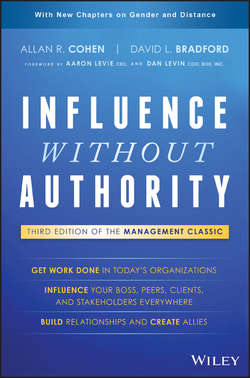Читать книгу Influence Without Authority - Cohen Allan R. - Страница 9
На сайте Литреса книга снята с продажи.
PART I
INTRODUCTION
CHAPTER 1
WHY INFLUENCE: WHAT YOU WILL GET FROM THIS BOOK
Barriers to Influence
ОглавлениеWe need to start by acknowledging that in some conditions influence is not possible (Table 1.3). There truly are impossible people (though far fewer than most people think). And some external conditions may block a working relationship. However, we have found that in most cases influence fails because of internal barriers within the influencer. Those are ones you have the most control over.
Table 1.3 Barriers to Influence
External Barriers
Too great a power differential between you and the person or group you want to influence. There may be such a hierarchical distance that it is impossible to make contact or the difference is so great that you have little to offer. But we often overestimate the inaccessibility of those even a couple of levels above us.
The people you want to influence have such different personal and organizational goals and objectives that you can't find common ground. This can be true or it can just reflect not searching deep enough.
The people you want to influence have incompatible performance measures. These may not let them respond to what you want. The measurement system may give them little latitude.
The people you want to influence are rivals, or feel competitive and don't want you to succeed. Or there might be too great a negative history between you (or your units) that cooperation is impossible. But organizations that fiercely compete with each other (like IBM and Microsoft) can find common ground in a specific product (like developing the chip for the Xbox).
These can be objective reasons why the other cannot be influenced, but be sure before you jump to that conclusion. You will see many examples of people who reached across several boundaries, who discovered things the other would want, who uncovered a common goal underneath the differences and who, with great effort, could build working relationships with previous adversaries
Internal Barriers
Occasionally, you can't overcome these external barriers, no matter how skilled an influencer you are. However, we have discovered that far more often, the barriers are inside the influencer.
These internal barriers include:
Lack of knowledge of how to go about influencing when there are objective difficulties. As instinctive as some kinds of influence are, many people do not have a very conscious idea of how to go about it when the other person or group is not responsive. They don't think of influence as a kind of exchange, and don't understand how important it is to deliver something the other person values, rather than what they themselves value. They emphasize how wonderful what they want is, and forget that it must appeal to something the other person or group cares about.
Attitudes that blind you to important objective information that would help you. Do you think that you shouldn't have to try to influence others; they should just recognize truth (or a better mousetrap) and give in? Another dysfunctional attitude is rapidly writing off anyone who doesn't quickly go along with a request, assuming that they are deficient in some important way. We will say a lot about this all-too-common barrier and how to overcome it. And another handicap is knowing what would move the other person but you can't stand people who want that, so you back off or become hostile.
Fear of the other person or group and how they might react. Frequently, people recognize that to gain influence they need to say something that might get the other person or group angry or wanting to retaliate. Out of fear, usually untested (and often unfounded), they decide they can't go ahead. Even the idea that pushing might make the other person not like you can paralyze some people.
Fear of failing. Most significant initiatives involve risk of failure/rejection, but some may be so concerned about embarrassment or shame that no attempt at influence is better than a refusal – or being accepted and then having the project or activity fail.
